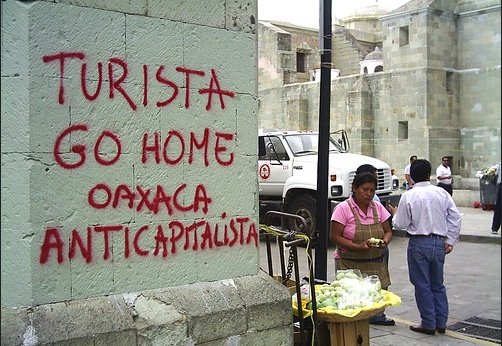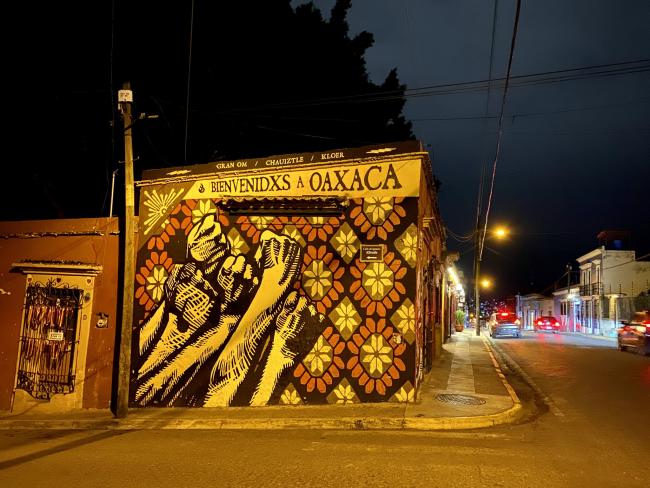
This December, we are asking readers to make a tax-deductible contribution before the year is over to ensure NACLA continues to provide only the best in progressive news and analysis on Latin America. Visit nacla.org/donate
Tourism is on the rise in the picturesque city of Oaxaca, known for its smoky mezcal, activist art scene, and diverse patchwork of Indigenous cultures. This year, visitors to the tiny airport in southern Mexico—where traffic is up 34 percent—were greeted by a billboard depicting smiling miners in a verdant field. “Welcome to Oaxaca,” the sign read, “where progress and nature coexist. Cuzcatlán Mining Company.”
Cuzcatlán is the wholly-owned subsidiary of Fortuna Silver Mines, a Vancouver-based company that operates a gold and silver mine an hour south of the airport. Fortuna says it contributes to the economy of the impoverished region. But native Zapotec residents accuse the multinational of inciting violence that has killed five activists. Last year, they say, a spill at Fortuna’s San José mining project unleashed toxic waste into the Coyote River, leaving one town without drinking water.
In October, affected residents gathered to protest Fortuna in an unexpected setting: the posh Fortín hotel in downtown Oaxaca City. There, hundreds of largely foreign guests were gathered for the awards ceremony of the annual Oaxaca Film Festival. Fortuna Silver Mines was a sponsor.
“We didn’t come to boycott this event,” said one activist in a skeleton mask and construction cap; “We came to express our firm rejection of the Fortuna Silver Mines company...which with just a few pesos tries to fool us into thinking it’s giving us development and social benefits, when in reality it’s taking the wealth of our subsoil and polluting our communities.”
The FilmFest responded to the protests by canceling its alliance with Fortuna. But the mining company continues to occupy strategic spaces throughout Oaxaca. From advertising at the airport to its sponsorship of the annual mezcal fair, the company has launched an intensified marketing campaign in areas that are a priority for the state’s growing tourism sector. As the Oaxacan government spends more on tourism, so too does Fortuna, which is a telling case study of the strategies used by extractive companies to co-opt state institutions, in Mexico and beyond.
A Record of Violations
The rugged sierras and tropical forests of Oaxaca are home to the greatest biological diversity in Mexico. They also produce some of the highest quantities of gold and silver in the country and contain the largest iron reserve in Latin America. Overall, mining companies with mostly foreign capital have secured rights to explore or exploit hundreds of square miles of this southern Mexican state.
Yet Oaxaca’s remarkable wealth is not shared with the majority of its residents, who are among the impoverished in Mexico. Even as the state boasts one of the highest rates of industrial growth in the country, more Oaxacans live below the poverty line today than 10 years ago. Experts point to San José del Progreso—where Fortuna has mined gold and silver mine since 2011—as emblematic of this phenomenon.
Fortuna Silver Mines advertises its contribution to the economy of this Indigenous Zapotec town: 70 percent of employees hail from the region, and the company has invested roughly $1 million a year in social programs. Yet opponents of the mine say the company’s investments in the community pale in comparison to its profits.
In 2017 alone, Fortuna’s Mexican subsidiary, Compañía Minera Cuzcatlán, reported a net income of $66.3 million. The company is among the top three silver producers in Mexico, which is in turn the top silver-producing country in the world. Meanwhile, in San José, the majority of residents lack basic services such as potable water and access to medical care. 88 percent of the population lives below the poverty line, with nearly half living in extreme poverty.
Since the arrival of Fortuna Silver Mines, life in San José has been characterized by deep division: There are two churches, two markets, and two separate taxi services used by supporters and opponents of the mine. “The tension is felt from the moment you cross the arch welcoming you into the community, which is actually a sort of checkpoint where a policeman with a large gun monitors who comes in and goes out,” wrote Paloma Villanueva for Oxfam Mexico.
“The community’s social fabric is still broken,” said Bernardo Vásquez, president of the Coordinadora de Pueblos Unidos del Valle de Ocotlán (Coordinator of the United Peoples of Ocotlán Valley, CPUVO), which organizes against the mine.
The conflict began in 2006, when representatives of Fortuna started signing usufruct agreements with individual landowners. The company also got permission to explore for minerals through closed-door negotiations with municipal authorities. Community members, however, were never informed of the company’s intention to exploit their subsoil, as is required by the International Labor Organization’s Indigenous and Tribal Peoples Convention 169.
In March 2009, a group of residents protested this violation of their rights by setting up an encampment at the entrance to the mine. In May, 1,000 state and federal police—acting at the request of the mining company and its local political allies—evicted protesters using helicopters, tear gas, and dogs.
Residents have also denounced violence at the hands of armed groups that are linked to municipal authorities and defend the interests of the mining company. In 2012, pro-mining groups attacked opponents several times using military-grade firearms. By the end of the year, two prominent activists had been killed and eight people had been injured. [See also on NACLA: Blood on the Silver]
More recently, communities near the mine accuse the company of environmental violence that threatens their access to vital resources like water. On an October morning a year ago, residents of the town of Magdalena Ocotlán sent out an alert: Following days of heavy rains, waste from the San José mining project had overflowed into the Coyote River, leaving behind a white, foul-smelling mud in the vicinity of the community’s drinking wells.
Mexico’s Environmental Protection Agency (Profepa) forced Cuzcatlán to pay a fine for the spill last March. Yet Profepa insists that no remediation plan is necessary, since levels of contaminants fall within the maximum permissible limits. Authorities of Magdalena, however, say they never received information on contaminants and continue to live in fear of the spill’s impacts.
“Since the day of the spill, drinking water service to the community was suspended,” community leaders recalled in a statement on the one-year anniversary of the spill. “But the situation of extreme poverty in which we have historically been maintained has caused most of our population to continue consuming water from the wells that are on the banks of the Coyote River.”
Turista, Go Home
In the wake of the spill, Fortuna Silver Mines has launched an intensified marketing campaign. Ads, promoted content on social media, and a radio program in San José depict a homebred company that values Oaxacan culture and creates opportunities for marginalized populations. Well-produced videos feature smiling women in a baking class, youth performing Indigenous dances, and hearing-impaired workers who have been empowered by their labor at the mine.
Recently, Cuzcatlán has also positioned itself in strategic spaces—such as the airport, mezcal fair, and the Oaxaca FilmFest—which receive state funding and are highly visible by tourists. This marketing strategy plays into that of the Oaxacan government, which has redoubled its promotion of tourism over the past decade.
“They’ve sold us the idea—and we’ve bought it very well—that Oaxaca is driven by tourism,” said César Sandoval, a theater professor and activist from Oaxaca City. This message is repeated “every day, and so you start to believe that tourism really is important for any one of us. And it’s not—it's important for businessmen, for the people who own hotels and transportation."
Sandoval and other activists interviewed say the contemporary form of this discourse was consolidated during Oaxaca’s 2006 uprising. On June 14 of that year, police violently evicted an encampment of striking teachers who were demanding better funding for education. But the government’s disproportionate use of force backfired, fueling the creation of a broad-based movement against endemic political corruption.
For months, citizens governed Oaxaca collectively through mass assemblies. They disrupted daily life in the city, blocking intersections and erecting barricades to protect their neighborhoods from police repression.
The revolt impacted the economy. In particular, the tourism and service sectors—long viewed as “strategic” and “primordial” in Oaxaca—cited significant losses. Forty hotels shuttered their doors and over 200 flights were canceled per month. The number of visitors to the state fell by 32 percent. The government and its business allies blamed activists for driving away tourists and bringing the economy to its knees.
Timing exacerbated the situation. Police evicted teachers just a month before the Guelaguetza, an annual cultural celebration that is Oaxaca’s most important tourist attraction. But the government’s efforts to clear the town square ahead of the event backfired. In 2006—and every year since—unionized teachers and their allies boycotted the week-long festival, arguing that its popular, Indigenous roots had been objectified to meet tourist needs, at prices only tourists could afford. A group of masked youth lit fire to the Guelaguetza auditorium and graffitied: “Turista go home, Oaxaca anticapitalista.” That year, the governor canceled the Guelaguetza.

For a Cinema and Territory Free of Mining
On an October day 13 years later, activists protested another prominent cultural event in Oaxaca: the annual film festival. Dozens of organizations issued a statement denouncing the “deplorable alliance” between Fortuna Silver Mines and the Oaxaca FilmFest, founded a decade ago by an American of Irani descent, Ramiz Adeeb Azar. At night activists interrupted the festival’s awards ceremony at the upscale Fortín hotel. “Out with Fortuna Silver Mines!” they shouted; “For a cinema and territory of free of mining!”
Festival-goers had diverse reactions to the protest. Some filmed the action and denounced the mining company on social media. Other simply avoided the ruckus or voiced frustration with protesters for interfering with their professional development. Hotel staff locked the entrance to the awards ceremony and a tall man started banging furiously on the doors, demanding to be let in. The police showed up.
Ana Lydia Monaco—a Mexican-American filmmaker who participated in the festival—described some of her peers’ responses to the protest as rooted in “a very white way of thinking”: portraying the activists as scary without bothering to understand the local political context. “They have no idea what Oaxaca is going through,” she added.
Monaco doesn’t blame the festival for the fiasco, since the organizers say they were unaware of the allegations against Fortuna Silver Mines. However, as a filmmaker whose work explores issues of diversity, she suggests the problem is one of representation. If there had been more local leadership and participation in the festival, perhaps its organizers would have known about the mining company’s record of violations. “If you are organizing an event in a country and a state that is not yours, the ideal situation would be to do your research,” Monaco added.
On the night of the protests, the Oaxaca Filmfest issued a statement announcing an end to its alliance with the mining company. “We are sensitive to the exhortation of society and the communities that have asked us to withdraw this sponsorship,” the organizing committee wrote.
Meanwhile, Cuzcatlán issued its own statement lamenting the festival’s decision. “We are in favor of generating jobs and publicizing the culture and traditions of Oaxaca,” the company wrote on Twitter. “Contributing to this task together with the Oaxaca FilmFest attracts tourists and honors the name of Oaxaca.”
Opponents had a different viewpoint. “How cynical,” replied one Twitter user. “Oaxaca doesn’t need the help of a mining company to honor the name of its peoples.”
Samantha Demby is an independent journalist and translator. She reports on extractive industries and traditional ecological knowledge in Mexico and Central America.

